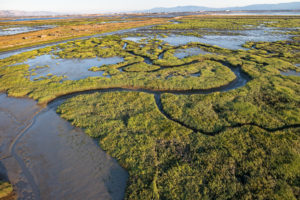Defining the edge of a shifting body of water like San Francisco Bay, whose exact extent changes with every tide, every season, every storm, can be tricky business. In our region the regulators sometimes fall back on a botanical criterion. In doubtful cases the Bay can be said to begin and end with the presence of a modest but important plant, the salt marsh gumplant, Grindelia stricta var. angustifolia.
As you would guess from its large yellow late-summer blossom, gumplant belongs to the sunflower family. As suggested by its name, it exudes a sticky, aromatic resin, which the Indians used to treat rashes. While cordgrass thrives under daily inundation and pickleweed favors perennially wet soil, gumplant likes its root zone better drained. It is found on higher or dryer ground within saltwater wetlands, like the natural levees that form alongside tidal channels—or on artificial dikes that have had their height reduced to improve habitat. The appearance of gumplant at Sonoma Baylands was an early sign of progress in its evolution to tidal marsh. Two to five feet tall, the gumplant is the giant of its zone. At its feet spread shorter plants whose common names evoke the environment they thrive in: saltgrass, alkali seaheath, sea lavender, fat hen. The clapper rail, the black rail, and the salt marsh harvest mouse all move up into gumplant stems for refuge when particularly high tides drive them from the pickleweed. The clapper rail uses the plant’s stems and leaf canopies as scaffolding for its nests, the San Pablo song sparrow roosts in its branches, marsh insects harvest gumplant nectar, and the mouse (like many birds) eats its seeds.
The role of gumplant as an edge marker says something about how the Bay has changed. Before their “reclamation,” salt marshes faded landwards into brackish marshes and other transitional habitats where Grindeliawas scarce or absent. Now most of these buffers are lost, and the typical marsh begins and ends at a steep-faced dike, with a fringe of gumplant climbing it. That’s fine for the plant but, because diketops are paths and perches for predators as well, not so fine for the creatures that depend on it for refuge.

.jpg)



